A few months back, we examined the performance of four liquid coolers for the Sandy Bridge-E socket LGA 2011 platform: Corsair's H80 and H100, Maingear's Epic 180, and Intel's own reference cooler. Liquid coolers are popular with high-end OEMs and some enthusiasts, but they aren't cheap -- and there's a certain group of enthusiasts who aren't comfortable with flowing liquid in their systems.
Recently, we spoke with the team at Noctua, who offered to send us one of its high-end air coolers for comparison. We've been curious about the company since it came across our radar with its upgrade offer for anyone upgrading to Socket 2011 last year.
Before we get started, we can't resist sharing the following:
Recently, we spoke with the team at Noctua, who offered to send us one of its high-end air coolers for comparison. We've been curious about the company since it came across our radar with its upgrade offer for anyone upgrading to Socket 2011 last year.
Before we get started, we can't resist sharing the following:

image credit: NewEgg .com
The banner above is running at NewEgg and it's hilariously inappropriate. Regardless of whether you favor air, liquid, or dropping your system in non-conductive oil, we promise you that it's *not* thirsty. Even if it somehow was, giving it a drink is a very bad idea. Like, feeding-Mogwai-after-midnight level bad.
Noctua's DH-14:
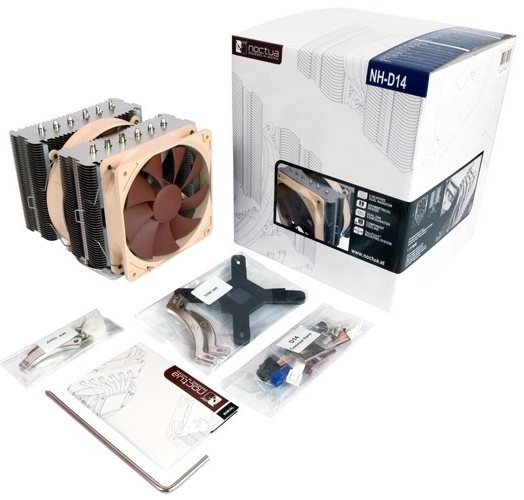
It's immediately obvious that Noctua takes a different approach than Intel and Corsair when it comes to product packaging and presentation. Both of the Liquid Cooler manufacturers are shipping what amount to rebadged third-party kits -- and it shows. All three products ship with the necessary mount hardware and a folded square of paper with diagrammed directions, and that's it. There's no accompanying text, no technical info on the fans or pump, nothing.
Noctua's DH-14 kit, in contrast, contains a full-color instruction brochure with numerous diagrams that show installation from various angles. It even includes a long screwdriver to aid with fan installation.
Does it matter? From a performance standpoint, no. An experienced enthusiast could figure out how to mount either kit without any instructions whatsoever; customers are ultimately concerned with how each cooler performs, not with how nice the packaging or documentation is. On the other hand, as someone with no previous experience with Noctua, the company's packaging, documentation, and the inclusion of a screwdriver were all impressive. Combined with the company's history of offering socket upgrade kits, it gives the impression of a manufacturer who views a cooler as a long-term investment.
The first thing you'll notice about the DH-14 isn't its high production values or even its unusual dual-fan design. The first thing we thought after opening the box was "Is this thing going to fit in a full-size enthusiast tower?" The answer is "yes," but pictures of the cooler on its own don't convey just how big it really is.
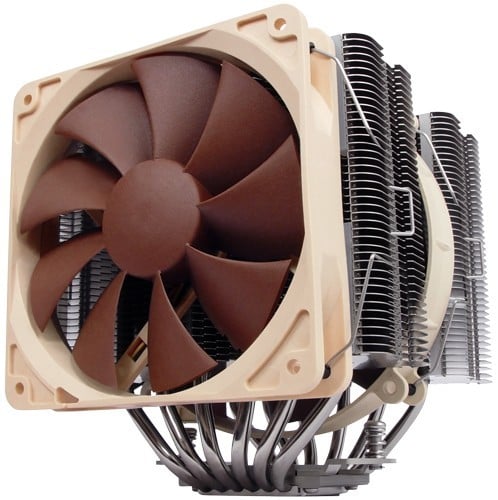
Don't let the silver finish fool you -- there's nickel over the copper to prevent oxidation from harming performance long-term.
Here's what it looks like when installed into a system.
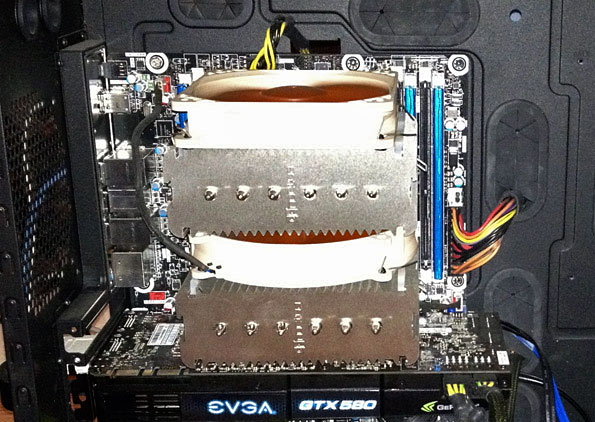
The DH-14 is 6.2" tall, 5.5" wide, and 6.2" deep with fan installed. It spans nearly half the width of the Intel X79 motherboard installed above (you can also see it resting just above the EVGA GTX 580 for comparison.) Weight, with fans installed, is 2.7 lbs. The cooler's weight isn't an inherent problem -- Intel's socket system is designed to handle it, and it's arguably just as (un)safe as having a liquid cooler installed. However, the DH-14 is big enough to overlap the RAM sockets and can't be used with all DDR2/DDR3 modules. Noctua's compatibility guidelines are here.
To be perfectly blunt, installation is a pain. We ultimately decided to pull the motherboard out of its case to simplify installation. This isn't a requirement, but trying to deal with the heatsink inside even a roomy 800D was more headache than it was worth. RAM installation can also be a headache; attaching the cooler first can make it easier to align things properly, but doing so makes it more difficult to put the RAM in afterwards.
Noctua has a reputation for excellent fans, and our experience with the NF-P12 and NF-P14 that ship with the NH-D14 was first-rate. The company also shipped us a pair of its NF-F12 PWM ultra-quiet fans.
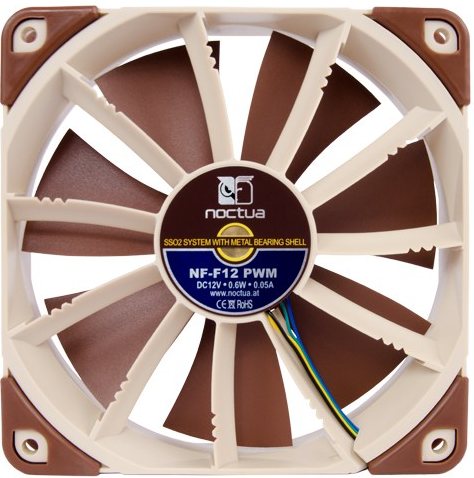
The NF-F12 PWM fan series. Note the stator vanes with their curved notches
These new designs incorporate a number of technologies aimed at improving cooler efficiency and reducing noise. At the heart of the new design is a technology Noctua calls Focus Flow. Focus Flow uses stator vanes to vary air compression across the fan blades as they turn.
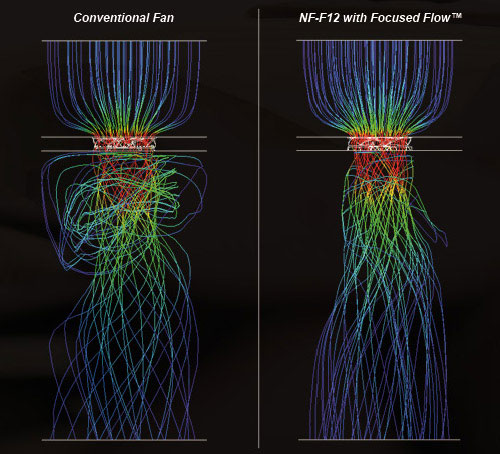
This diagram from Noctua is meant to illustrate the benefit of using Focus Flow, but it also demonstrates why adding a second fan to a conventional liquid cooler in a push/pull configuration (as the H100 and H80 do) yields only a small additional improvement. Forcing air over a heatsink creates an area of low pressure directly behind it; the air swirling through this area is called an eddy. Adding a second fan without accounting for the additional turbulence means that a majority of the potential cooling benefit is canceled out.
The company's website details each and every improvement its made to the NF-F12 PWM, including its adoption of a new PWM. We swapped the DH-14's fans for the pair of NF-F12's in our review; comparative results are included in the benchmark data. The DH-14 may be made by Noctua, but it's not necessarily an ideal platform for this type of test. The heatsink's standard fans come with pre-attached clips; we had to finagle the NF-F12's into place to get them to fit. In addition, the extra dampening material around the edges of the NF-F12 fans give them a bit less room when wedged between the two heatsinks.
So, it's expensive and somewhat difficult to install. How's it perform?
Test Methodology: All tests were conducted using Intel's Core i7-3960X hexa-core Sandy Bridge-E CPU and DX79SI Siler motherboard. Windows 7 was set to 'Balanced' power mode. Idle temperatures were measured after allowing the system to sit post-boot for 10 minutes. Load temperatures were measured after running Intel's stress test as included in the company's Extreme Tuning Utility (XTU) for one hour. Peak temperatures were taken while running Prime95 for two hours, with that utility configured for maximum heat and power consumption.
We used a Corsair 800D chassis to test mounting and fittings, but left the chassis open. Testing was conducted with the stock fans (labeled as the DH-14) and with two NF-F12 PWM fans installed.
Intel's stress test appears to load the CPU nearly as well as Prime95, but since it's not widely available, we went with Prime as a generally known and easily replicable test.
Our stock speed and 4.13GHz comparisons were done with the Corsair coolers in 'Quiet' mode (lowest setting). Our 4.5Ghz test required us to increase fan speeds; so we brought both coolers up to the 'Performance' preset (highest setting). Note that Intel's cooler uses a four-pin fan and default BIOS settings that focus more on quiet operation than maximum performance. During our stock test, the RTS2011LC's fan never spun faster than ~875 RPM.
We used a Corsair 800D chassis to test mounting and fittings, but left the chassis open. Testing was conducted with the stock fans (labeled as the DH-14) and with two NF-F12 PWM fans installed.
Intel's stress test appears to load the CPU nearly as well as Prime95, but since it's not widely available, we went with Prime as a generally known and easily replicable test.
Our stock speed and 4.13GHz comparisons were done with the Corsair coolers in 'Quiet' mode (lowest setting). Our 4.5Ghz test required us to increase fan speeds; so we brought both coolers up to the 'Performance' preset (highest setting). Note that Intel's cooler uses a four-pin fan and default BIOS settings that focus more on quiet operation than maximum performance. During our stock test, the RTS2011LC's fan never spun faster than ~875 RPM.
We tested the Noctua DH-14's fans at 50% for Stock and 4.13GHz and increased them to 75% for the 3.5GHz test. Here's what stock performance looked like:

At stock speeds, the DH-14 is just as capable as the Corsair H80 and outperforms the Intel RTS2011. Only the H100, at $119, offers better performance. The NF-F12 fans essentially tie the default options. What happens when we start overclocking?
|
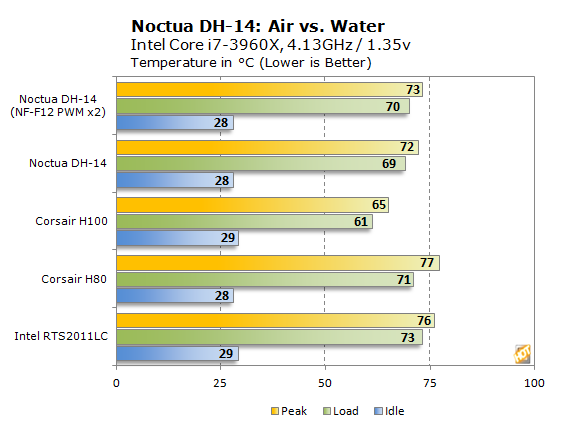
At 4.13GHz, the DH-14 is actually better than both the H80 and Intel coolers. The H100 remains ~7C cooler, but Noctua's air cooler can clearly keep up. Our 4.5GHz test raises the CPU voltage still further, but increases fan speeds to compensate.

Higher fan speeds bring the H80's temperatures back in line with the DH-14, while the H100 retains a consistent advantage. Both OC tests show a small advantage for the default fans, though this could be small variations in ambient temperature.
Noise Levels:
We didn't have measuring equipment precise enough for a qualitative comparison of dB levels, which would give you an idea how quiet all of these solutions are to begin with. With that said, there are some qualitative points we can discuss.
At stock speeds, the fans on the liquid coolers, and on the Noctua DH-14, are all inaudible. We use that word for a reason--unlike "silent," which is often modified with unclear words like "virtually," something is either audible or it isn't. Standing in a room with no external fan noise, central air/heat, TV, or music, you can't hear any of the fans. What you can hear are the liquid coolers' pumps. Not much--but in the rareified air of $90 coolers, people care about those tiny differences.
At 4.5GHz, the H100 is quieter than the DH-14 or the H80—but it's also significantly more expensive.
As for Noctua's NF-P12 fans, their chief advantage over the stock options is that they have a PWM to allow for dynamic, on-the-fly adjustments. That's not a knock against them--the idea of paying $89 for a cooler with substandard stock fans is a much greater turn-off than the fact that they don't improve the already-excellent performance of the DH-14. In point of fact, it'd be difficult for any high-end cooler to improve on what the DH-14 offers—it's really just that good.




Tidak ada komentar:
Posting Komentar